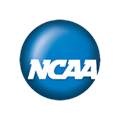
National Collegiate Athletic Association |
The NCAA News - Briefly in the NewsSeptember 13, 1999
Athletes at risk for bone disease
Athletic, healthy-looking female student-athletes may be at risk for osteoporosis, a serious disease normally seen in frail, elderly women. Caused by inadequate calcium, osteoporosis thins the bones and makes them susceptible to breaks. Some sufferers are unable to compete any more, effectively ending many careers before they begin. While exercise and a healthy diet promote bone growth, experts say an increasing number of young girls and women are suffering from osteoporosis because they have inadequate calcium stores -- likely caused from excessive exercise and inadequate calorie intake. In an effort to stay thin -- either for competitive advantage or for aesthetics -- an increasing number of young athletes have taken an extreme route with excessive dieting and intensive exercise. That leads to amenorrhea -- which essentially indicates that the body, believing it is starving, shuts down the reproductive system -- and premature osteoporosis. While the long-term effects of the disease are unknown, short-term consequences are the same as for older women: the increased chance of fractures to the spine, hip and legs. For young athletes, even a mild eating disorder during adolescence can cause problems. "A lot of girls out there who are doing sports are very focused on their weight," Karen R. Rubin, a pediatric endocrinologist at Connecticut Children's Medical Center, told The Hartford Courant. "Because of the exercise, they don't need as much disordered eating to become amenorrhic." The more serious condition is easily misidentified because amenorrhea also occurs in healthy athletes, who may consider it a badge of fitness. "Menstrual dysfunction happens all the time to athletes, but I tell them it's not OK, it's not normal," said Marge Putukian, a team physician at Pennsylvania State University. "There are consequences that at this point we do not think are reversible." Student-athletes at many universities are screened for eating disorders and receive nutritional counseling, but the problem may begin as early as junior high and high school, when bones are in an active growth period. Studies on the long-term effects of calcium deficiencies have not found any indication that the problem is reversible. While doctors say athletes at highest risk are in sports like distance running, gymnastics and figure skating, any athlete can suffer from it. "I've seen it in soccer, field hockey, swimming, diving, basketball, tennis, track, even golf," Putukian said. Coaches vs. Cancer, part IIWomen's collegiate basketball is getting into the game against cancer with the inaugural Coaches vs. Cancer Challenge women's basketball tournament this fall. The University of Connecticut, Clemson University, Old Dominion University and the University of Kentucky will participate in the event November 24 and 26 at the Hartford Civic Center in Hartford, Connecticut. "The Women's Basketball Coaches Association (WBCA) and its members are proud to be a part of such a prestigious and worthwhile event as the Coaches vs. Cancer Challenge," said Beth Bass, WBCA executive director. "The women's basketball community was recently humbled by the death of Kim Perrot (of the WNBA's Houston Comets) who died after battling cancer. The WBCA itself has lost members to this dreadful disease, and I know our coaches feel strongly about helping in the search for a cure." The new tournament will complement the men's version, the Coaches vs. Cancer IKON Classic, in a national fight against cancer. Proceeds will benefit the American Cancer Society. For more information, see the Web site at www.gazellegroup.com. 'Adult' ads get puntedSports fans in Minneapolis won't have to wade through R-rated advertising to get to the sports news anymore. The Minneapolis Star Tribune recently announced that it has moved "adult" ads -- featuring sexually oriented nightclubs and videos -- from the sports section to the classified section of the paper. The move was prompted by readers' concerns that children and teens checking the box scores or reading sports articles were being exposed to the ads, which featured 900-numbers and provocative photos. A book for football fansCollege football fans will again be able to check statistics, rosters and schedules of every Division I-A football team in Perelman's College Football Companion, which debuted last fall. Produced by Rich Perelman, the long-time official scorer for the University of California, Los Angeles, the guide is available online this year at Amazon.com, BarnesandNoble.com and Borders.com.
-- Compiled by Kay Hawes |
